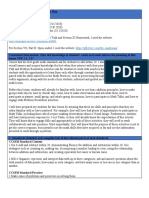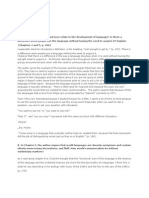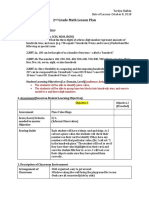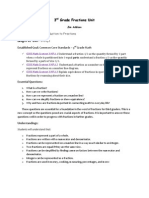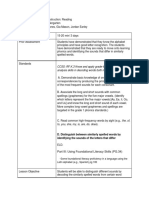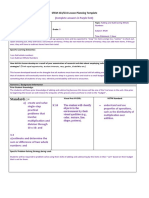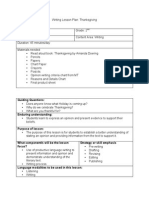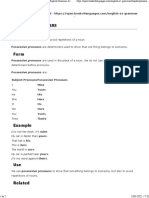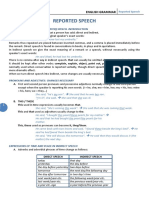0 ratings0% found this document useful (0 votes)
458 viewsMath Lesson Plan: Fractions
Math Lesson Plan: Fractions
Uploaded by
BeverlyCortezThe lesson plan is for a 3rd grade math class on fractions. The lesson introduces finding fractions of groups of objects using a problem about sharing 12 apples. Students work on word problems involving fractions of 12 and use objects or drawings to solve them. Example problems include finding 1/3 and 1/3 of 12 apples and 1/4, 1/4, and 1/4 of 12 apples. The teacher assesses students' understanding by observing their work and using a rubric to record their proficiency with fractions concepts.
Copyright:
© All Rights Reserved
Available Formats
Download as DOCX, PDF, TXT or read online from Scribd
Math Lesson Plan: Fractions
Math Lesson Plan: Fractions
Uploaded by
BeverlyCortez0 ratings0% found this document useful (0 votes)
458 views9 pagesThe lesson plan is for a 3rd grade math class on fractions. The lesson introduces finding fractions of groups of objects using a problem about sharing 12 apples. Students work on word problems involving fractions of 12 and use objects or drawings to solve them. Example problems include finding 1/3 and 1/3 of 12 apples and 1/4, 1/4, and 1/4 of 12 apples. The teacher assesses students' understanding by observing their work and using a rubric to record their proficiency with fractions concepts.
Original Description:
Math Lesson Plan: Fractions
Copyright
© © All Rights Reserved
Available Formats
DOCX, PDF, TXT or read online from Scribd
Share this document
Did you find this document useful?
Is this content inappropriate?
The lesson plan is for a 3rd grade math class on fractions. The lesson introduces finding fractions of groups of objects using a problem about sharing 12 apples. Students work on word problems involving fractions of 12 and use objects or drawings to solve them. Example problems include finding 1/3 and 1/3 of 12 apples and 1/4, 1/4, and 1/4 of 12 apples. The teacher assesses students' understanding by observing their work and using a rubric to record their proficiency with fractions concepts.
Copyright:
© All Rights Reserved
Available Formats
Download as DOCX, PDF, TXT or read online from Scribd
Download as docx, pdf, or txt
0 ratings0% found this document useful (0 votes)
458 views9 pagesMath Lesson Plan: Fractions
Math Lesson Plan: Fractions
Uploaded by
BeverlyCortezThe lesson plan is for a 3rd grade math class on fractions. The lesson introduces finding fractions of groups of objects using a problem about sharing 12 apples. Students work on word problems involving fractions of 12 and use objects or drawings to solve them. Example problems include finding 1/3 and 1/3 of 12 apples and 1/4, 1/4, and 1/4 of 12 apples. The teacher assesses students' understanding by observing their work and using a rubric to record their proficiency with fractions concepts.
Copyright:
© All Rights Reserved
Available Formats
Download as DOCX, PDF, TXT or read online from Scribd
Download as docx, pdf, or txt
You are on page 1of 9
ITE 325 Lesson Plan Format
Name: Beverly Cortez Title: Fractions
Grade Level and Setting: 3
rd
Grade, Classroom 33
Date Taught: March 12 Duration: 50 minutes
Number of Students: 26
Overarching Mathematical Goal(s):
Students will
Find fractions of groups of objects
o Find and name fractional parts of 12 objects
o Use pictures or models to show that they have identified the correct fraction
Consider Your Students Needs:
Considering All Students:
Students must have worked with an area model for fractions. Area models include circle
and rectangle. Some, if not the majority, of students can find parts of a single whole.
They may be able to write the correct fractional name.
Students have experience fractions with paper models. They were able to find equal
parts of a whole like halves, fourths, eights, thirds and sixths. Some students had
difficulty partitioning the paper into 3 equal parts (thirds).
For English Language Learners:
Explain the terms groups, fair shares, equal parts, halves, fourths, thirds, eighths, and
twelves. Also, review structures of fractions and the conventions for reading fractions.
Allow peer-assisted learning. Students will be paired with another student that has a
deep understanding of the concept of fractions.
For Students with Special Needs:
Mild disabilities:
If students are unable to solve the problem independently, they will benefit from a
peer-assisted learning. Students will be paired with another student that has a deep
understanding of the concept of fractions.
Provide only one problem or a different problem sheet that is easier.
For Fast Finishers:
Ask students to draw pictures for each of the problems to represent each fraction. They
will then use their drawing in justifying their answer to the class.
Ask students to create their own sharing of 12 things problem.
Ask students to examine the problems and see if they noticed anything.
Ask students to help other students who are having trouble.
Materials Needed:
Each student will need:
Paper
Pencil
12 buttons or 12 connecting cubes or 12 colored tiles
Sharing 12 things problem sheet
Teacher will need:
White board
Dry erase marker
12 buttons or 12 connecting cubes or 12 colored tiles
26 copies of sharing 12 things problem sheet
Sources:
Elementary and Middle School Mathematics: Teaching Developmentally (2013) by Van
de Walle, Karp, Bay-Williams
Standard/Benchmark
HCPSIII/Common Core Content Standards:
3.NF.1. Develop understanding of fractions as numbers. Understand a fraction 1/b as the
quantity formed by 1 part when a whole is partitioned into b equal parts; understand a fraction
a/b as the quantity formed by a parts of size 1/b.
Common Core Standards for Mathematical Practice:
CCSS.Math.Practice.MP1: Make sense of problems and persevere in solving them
CCSS.Math.Practice.MP2: Reason abstractly and quantitatively
CCSS.Math.Practice.MP4: Model with Mathematics
Assessment
Observe:
Are students partitioning correctly?
Are they making fair shares?
Are they using pictures or models to help them with the problem?
Record observations about students while they are working on the problems.
Assessment Recording Sheets and/or Rubrics:
+ Yes
+/- Sometimes
X No
Student Partitions to
solve
problems;
makes fair
shares
Able to find
fractional
parts of 12
objects
Able to
name
fractional
parts of 12
objects
Used
pictures or
models to
show that
they have
identified
the correct
fraction
Comments
Activities/Instructional Strategies
BEFORE:
Get students attention and say:
We have been finding fractions of rectangles, which are single objects that can be cut
up into equal parts. It is also possible to find fractions of a group of things. Think about
this: I have 12 marbles in my collection. I want to give my friend half of them. How many
marbles will I give to my friend?
Allow students to consider this for a minute or two, and then ask a few students
to explain how they thought about the question. As students share, encourage
them to draw pictures that represent the problem on the board. Tell them to use
their picture to explain and justify their answer.
Students might say:
I drew 12 circles, one for each marble, in a line. I drew a line across the middle of
the marbles so that there was the same number of marbles on each side. I counted
the marbles on one side and it is 6. So you gave her 6 marbles.
I know that 6+6=12. So half of 12 is 6.
I started putting out 12 cubes, but when I counted out 6 I realized that half of 12
things is 6 things because 6 fits into 12 evenly twice.
Allow student to show his or her strategy to the rest of the class.
Say:
Good, so in order to have a fair share of my 12 marbles, my friend and I will need to
have the same amount of marbles. I will give my friend 6 marbles because half of 12
is 6.
Record on the board of 12 is 6
Say:
In this problem, what is our whole?
DURING:
Say:
Today you will be solving some problems about sharing 12 apples. Think about how you
can picture these problems. You may want to use cubes, buttons, colored tiles,
drawings or any other materials that you think might be useful.
Pass out sharing 12 things problem sheet to students:
Solve each of these problems and show how you figured out your answers:
1. Oscar picked 12 apples. He gave 1/3 of the apples to Gil and 1/3 of the
apples to Becky. How many apples did each of them get?
2. Pilar picked 12 apples. She gave of the apples to Dwayne, of the apples
to Murphy, and of the apples to Kelley. How many apples did each of them
get?
3. Chiang picked 12 apples. She gave 1/6 of the apples to each of her 5 friends.
How many apples did each friend get?
Say: Make sure you label your answers and drawings.
Circulate as students work and use assessment chart.
Ask questions to elicit responses and take note if student understand the
concept and take note of any misunderstandings.
For fast finishers:
1. Find a partner who is done and share your answers. Compare your work.
Explain your answer using your picture or model.
2. Find a partner who is finished and examine the three problems and see if
you noticed anything
3. Create your own sharing of 12 things problem.
4. Find a partner who is struggling and needs help.
AFTER:
Get students attention and have a class discussion. Use their class attention
getter.
You found many fractions of 12 when you solved the problems about 12 apples. Lets
record what you found. Draw student numbers to be fair
Ask one student to read problem number 1.
Ask one of the fast finishers to come up and share his or her answer to the class.
Tell student to show pictures or use models in justifying his or her answer
Thank student for sharing
Call on one student to record fractions of 12 on the board: 1/3 of 12 is 4
Ask students if they got this problem correct.
Note who didnt raise their hand
Ask another student to read problem number 2.
Ask another one of the fast finishers to come up and share his or her answers to
the class using pictures or models to justify answer.
Thank student for sharing
Call on another student to record fractions of 12 on the board: of 12 is 3
Ask students if they got this problem correct.
Note who didnt raise their hand
Ask another student to read the last problem.
Ask another one of the fast finishers to come up and share his or her answer to
the class using pictures or models to justify the answer.
Thank student for sharing
Call on another student to record fractions of 12 on the board: 1/6 of 12 is 2
Ask students if they got this problem correct.
Note who didnt raise their hand
Ask students who created their own sharing 12 things problems to share
Give students time to work on the problem.
Say
You know how to find fractions of 12 from this activity, what about finding a fraction of a
different number? How many students is of our class?
Ask: how many students is in our class?
Students respond: 26
So what is half of 26?
Allow students a few minutes to work on this with a partner. Encourage students
to use pictures, models or other materials that might be useful to them.
Collect responses
Have a few students share how they divided the class in half.
Record answer on the board.
If time permits: pose another problem with a different number of students
If 2 people were absent and we wanted to divide the class in half, how many would be
in each half?
Conclude the lesson by asking a few questions;
Is it possible to find a fraction of one rectangle?
Is it possible to find a fraction of one circle?
What about a fraction of a group of objects? Like 20 oranges
Assign homework sheet (attached)
Assessment Recording Tool:
Student Partitions to
solve
problems;
makes fair
shares
Able to find
fractional
parts of 12
objects
Able to
name
fractional
parts of 12
objects
Used
pictures or
models to
show that
they have
identified
the correct
fraction
Comments
Any other resources needed (worksheets, data tables, etc):
Sharing 12 Things
Solve each of these problems and show how you figured out your answers.
1. Oscar picked 12 apples. He gave 1/3 of the apples to
Gil and 1/3 of the apples to Becky. How many apples
did each of them get?
2. Pilar picked 12 apples. She gave of the apples to
Dwayne, of the apples to Murphy, and of the
apples to Kelley. How many apples did each of them
get?
3. Chiang picked 12 apples. She gave 1/6 of the apples
to each of her 5 friends. How many apples did each
friend get?
Homework
1. Katy bought 20 roses. She wants to give of the
roses to her mom, sister, her friend Jennifer and her
friend Kim. How many roses should she give each of
them?
2. Amy has 12 lollipops. She gave 1/6 of the lollipops to
each of her 5 friends. How many lollipops did each
friend get?
3. Create your own word problem that shows a fractional
part of a group of objects. Use the problems above to
guide you.
You might also like
- Place Value UbD UnitDocument10 pagesPlace Value UbD Unitkathryn moodyNo ratings yet
- Lesson Plan Informational WritingDocument4 pagesLesson Plan Informational Writingapi-279823017100% (2)
- Lesson Plan Template For Residency Students 12-3Document5 pagesLesson Plan Template For Residency Students 12-3Tahtiana BrooksNo ratings yet
- Ted 410 Math LessonDocument9 pagesTed 410 Math Lessonapi-486956371No ratings yet
- Mathematics Lesson Plan For Kindergarten: 1. Title of The Lesson: Geometry-Shapes 2. Brief Description of The LessonDocument5 pagesMathematics Lesson Plan For Kindergarten: 1. Title of The Lesson: Geometry-Shapes 2. Brief Description of The LessonMaggie GorskaNo ratings yet
- Te 331 Math Lesson CinerDocument16 pagesTe 331 Math Lesson Cinerapi-494433412No ratings yet
- Literacy Lesson PlanDocument4 pagesLiteracy Lesson PlanAnnie Jeannette Garza0% (1)
- Lesson Plan 4 429 GarciaDocument3 pagesLesson Plan 4 429 Garciaapi-212740470No ratings yet
- Teacher Work SampleDocument28 pagesTeacher Work Sampleapi-437973397No ratings yet
- 3rd Grade Lesson PlansDocument5 pages3rd Grade Lesson Plansapi-3559611970% (1)
- Story Sequencing 4day Lesson Based On The Rainbow FishDocument6 pagesStory Sequencing 4day Lesson Based On The Rainbow Fishapi-291126949No ratings yet
- Lesson PlansDocument6 pagesLesson Plansapi-443510939No ratings yet
- Student Teaching - Water Cycle Lesson 1Document2 pagesStudent Teaching - Water Cycle Lesson 1api-346526495No ratings yet
- Performing Arts Lesson PlanDocument12 pagesPerforming Arts Lesson PlanBeverlyCortezNo ratings yet
- Performing Arts Lesson PlanDocument12 pagesPerforming Arts Lesson PlanBeverlyCortezNo ratings yet
- 3a Power of Babel-7-11Document3 pages3a Power of Babel-7-11api-273275279No ratings yet
- Tayler Logue Math Lesson Plan - Grade 4Document4 pagesTayler Logue Math Lesson Plan - Grade 4api-373654763No ratings yet
- Lesson Plan 1 Array Models For MultiplicationDocument3 pagesLesson Plan 1 Array Models For Multiplicationapi-401539837No ratings yet
- Module 5 - Lesson Plan Story ElementsDocument6 pagesModule 5 - Lesson Plan Story Elementsapi-289506791No ratings yet
- Math Lesson Plan ReflectionDocument8 pagesMath Lesson Plan Reflectionapi-338530955No ratings yet
- 2nd Grade Math Lesson Plan 3-Digits PDFDocument7 pages2nd Grade Math Lesson Plan 3-Digits PDFapi-430893986No ratings yet
- 3rd Grade Fractions UnitDocument7 pages3rd Grade Fractions Unitapi-218275263No ratings yet
- Edtpa Lesson PlanDocument5 pagesEdtpa Lesson Planapi-340408921No ratings yet
- K-3 Lesson Plan Framework: Cake To Answer Comprehension QuestionsDocument5 pagesK-3 Lesson Plan Framework: Cake To Answer Comprehension Questionsapi-278470419No ratings yet
- Lesson Plan #2Document6 pagesLesson Plan #2Jason DonaldsonNo ratings yet
- Lesson Plan LiteracyDocument4 pagesLesson Plan Literacyapi-570789490100% (1)
- Math LessonDocument8 pagesMath Lessonapi-464778396No ratings yet
- Kindergarten Unit 6 Outline Overview 2017Document33 pagesKindergarten Unit 6 Outline Overview 2017api-401628488No ratings yet
- Itl 518 Science UnitDocument12 pagesItl 518 Science Unitapi-478853478100% (1)
- Literacy Lesson PlanDocument4 pagesLiteracy Lesson Planapi-507074543No ratings yet
- Part e - Planning CommentaryDocument10 pagesPart e - Planning Commentaryapi-446884620100% (1)
- Third Grade Math LessonDocument6 pagesThird Grade Math Lessonapi-591042996No ratings yet
- Schrecengost Itl 518 Learning MapDocument6 pagesSchrecengost Itl 518 Learning Mapapi-488269992100% (1)
- Mini Lesson Plan 7Document3 pagesMini Lesson Plan 7api-260889954100% (1)
- Lesson Plan Ted 508Document4 pagesLesson Plan Ted 508api-486161267100% (1)
- Savannah Bakker 1 Grade - Converse Elementary School Indiana Wesleyan University Elementary Education Lesson Plan Lesson RationaleDocument10 pagesSavannah Bakker 1 Grade - Converse Elementary School Indiana Wesleyan University Elementary Education Lesson Plan Lesson Rationaleapi-437989808No ratings yet
- Planning CommentaryDocument8 pagesPlanning CommentaryShealagh Lyons100% (1)
- Reflection For Math Lesson 30-40Document1 pageReflection For Math Lesson 30-40api-336072959100% (1)
- Whole Number Place ValueDocument4 pagesWhole Number Place Valueapi-234983083No ratings yet
- C Canfield Edtpa Unit PlanDocument16 pagesC Canfield Edtpa Unit Planapi-242212465No ratings yet
- Edtpa Lesson PlansDocument12 pagesEdtpa Lesson Plansapi-34049548767% (3)
- Final 5e Lesson Plan - Grocery StoreDocument4 pagesFinal 5e Lesson Plan - Grocery Storeapi-548497656No ratings yet
- Lesson Plan - MathsDocument4 pagesLesson Plan - Mathsapi-250080978No ratings yet
- Kagan Lesson Plan 4th Grade Social StudiesDocument9 pagesKagan Lesson Plan 4th Grade Social Studiesapi-603442952No ratings yet
- Lbs 405 5e Lesson Plan RationaleDocument3 pagesLbs 405 5e Lesson Plan Rationaleapi-457177416No ratings yet
- Tpa 3 - Assessing Student LearningDocument49 pagesTpa 3 - Assessing Student Learningapi-317738807100% (9)
- Unit Plan Math Lesson 3 of 6Document4 pagesUnit Plan Math Lesson 3 of 6api-193663371No ratings yet
- K - Animals and Plant NeedsDocument12 pagesK - Animals and Plant NeedsZaw WynnNo ratings yet
- Map Skills Lesson Plan 1Document7 pagesMap Skills Lesson Plan 1api-240434269100% (1)
- Writing Lesson Plan April 26thDocument3 pagesWriting Lesson Plan April 26thapi-3566001480% (1)
- Area and Perimeter 4th GradeDocument4 pagesArea and Perimeter 4th Gradeapi-399721315No ratings yet
- Completed Math Approved Lesson PlanDocument8 pagesCompleted Math Approved Lesson Planapi-340175370No ratings yet
- Math Lesson PlanDocument11 pagesMath Lesson Planapi-3142478620% (1)
- Year 5 t1 Unit 6Document10 pagesYear 5 t1 Unit 6api-267136654No ratings yet
- 1st Grade Reading Lesson PlanDocument5 pages1st Grade Reading Lesson Planapi-483325082100% (1)
- Compare and Contrast Lesson Plan Template01 2Document3 pagesCompare and Contrast Lesson Plan Template01 2api-506215661No ratings yet
- Millicent Atkins School of Education: Common Lesson Plan TemplateDocument5 pagesMillicent Atkins School of Education: Common Lesson Plan Templateapi-505035881No ratings yet
- edTPA-Task 1 Day 1Document2 pagesedTPA-Task 1 Day 1Chelsea Keeney100% (1)
- Math Lesson Plan 2Document12 pagesMath Lesson Plan 2api-456889650No ratings yet
- Lets Learn About Capacity Focus Area 2Document18 pagesLets Learn About Capacity Focus Area 2api-293919801No ratings yet
- Lesson Plan - Little Red Hen: Comprehending: SequenceDocument2 pagesLesson Plan - Little Red Hen: Comprehending: Sequenceapi-375889476No ratings yet
- Equivalent FractionsDocument14 pagesEquivalent FractionsBeverlyCortezNo ratings yet
- Student Reading SurveyDocument37 pagesStudent Reading SurveyBeverlyCortezNo ratings yet
- Co-Teaching ReflectionDocument4 pagesCo-Teaching ReflectionBeverlyCortezNo ratings yet
- Writing Lesson PlanDocument10 pagesWriting Lesson PlanBeverlyCortezNo ratings yet
- Expert Cae AdvancedDocument4 pagesExpert Cae AdvancedAnonymous yyzxrD3No ratings yet
- 5 6179165823802803603Document401 pages5 6179165823802803603Alpha PubgNo ratings yet
- Existence of Ananda in Dhvani's TheoryDocument12 pagesExistence of Ananda in Dhvani's TheoryAnkur AryaNo ratings yet
- English Grammar A1 Level Possessive Pronouns - English Grammar A1 Level PrintDocument2 pagesEnglish Grammar A1 Level Possessive Pronouns - English Grammar A1 Level PrintBooks for languagesNo ratings yet
- New SyllabusDocument6 pagesNew Syllabusanirudh raghunathNo ratings yet
- Sentence ElementsDocument13 pagesSentence ElementsTăng Nhạc ÝNo ratings yet
- Module 4 - THM 12 - Part 1Document9 pagesModule 4 - THM 12 - Part 1Djared James MinasNo ratings yet
- Supporting Young Children's Emotional Well-Being: Cumbria County CouncilDocument32 pagesSupporting Young Children's Emotional Well-Being: Cumbria County CouncilAlbina ScutaruNo ratings yet
- Philosophy of EducationDocument7 pagesPhilosophy of Educationapi-696797501No ratings yet
- Unit 7 - Modal Verbs Of: Ability, Possibility and ObligationDocument9 pagesUnit 7 - Modal Verbs Of: Ability, Possibility and ObligationFatima OLGUNNo ratings yet
- Consumer BehaviourDocument8 pagesConsumer BehaviourTwinkle JaiswalNo ratings yet
- Barrett TaxonomyDocument25 pagesBarrett Taxonomyklepek100% (2)
- Observation 3 Fractions Lesson PlanDocument7 pagesObservation 3 Fractions Lesson Planapi-724496358No ratings yet
- Business Communication NotesDocument55 pagesBusiness Communication NotesAditya vijayvargiyaNo ratings yet
- Lesson Plan AmgDocument2 pagesLesson Plan AmgDinca IleanaNo ratings yet
- Adult ColoringDocument37 pagesAdult ColoringAkane Soprano94% (16)
- Forgetting-Causes of ForgettingDocument10 pagesForgetting-Causes of ForgettingSaeed AlzahraniNo ratings yet
- Plurality of EnglishDocument5 pagesPlurality of EnglishJovie VistaNo ratings yet
- Microteaching (Theory Into Practice) Module 2022Document60 pagesMicroteaching (Theory Into Practice) Module 2022Its MehNo ratings yet
- English Viii SyllabusDocument3 pagesEnglish Viii Syllabusmsuleman111No ratings yet
- Ge1 Exam Reviewer PersDocument5 pagesGe1 Exam Reviewer PersRJ 1No ratings yet
- English AccomplishmentDocument2 pagesEnglish AccomplishmentJasmin QuarterozNo ratings yet
- Direct and Indirect (Or Reported) Speech. IntroductionDocument13 pagesDirect and Indirect (Or Reported) Speech. IntroductionShafira AnandaNo ratings yet
- EED16 Module 3Document9 pagesEED16 Module 3Laiza Mia Jane TapicNo ratings yet
- Phrasl VerbsDocument15 pagesPhrasl VerbsEdoardo ColomboNo ratings yet
- Conceptual FrameworkDocument7 pagesConceptual FrameworkPiyam RazaNo ratings yet
- Fun Theory StairsDocument19 pagesFun Theory StairsCarla Lourraine TanNo ratings yet
- Assertiveness and Self-Confidence SampleDocument27 pagesAssertiveness and Self-Confidence SampleUchechukwu Magnus EbukaNo ratings yet
- Lesson Plan - Energy FlowDocument3 pagesLesson Plan - Energy Flowapi-644456588100% (1)



